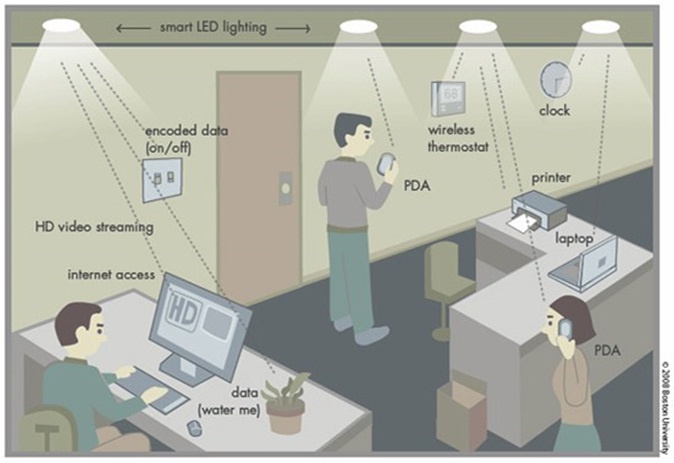
Picture this-you wake up and tap your smartphone to switch on your coffee machine. As you make breakfast, your refrigerator sends you a text that you’re out of orange juice. Clued-in with this message, your car’s GPS routes you to the grocery shop on your way back from work, as you use your phone to switch on your home heating system, so things are toasty warm when you get back. At the forefront of this connectivity phenomenon popularly known as the ‘Internet of Things’, is an optical communication technology that’s taking the world by storm. Light Fidelity or Li-Fi, is an exciting breakthrough in 5G visual light communication systems and the future of wireless Internet access.
With Li-Fi, information hitches a ride along a spectrum of visible light. Light-emitting diode (LED) bulbs, transmit data when they are switched on and off so rapidly in nanoseconds, that the human eye cannot see it. This data is registered by special equipment, making it possible to provide wireless Internet connectivity at a current experimental speed up to 10 Gbps, which is estimated to be 250 times faster than ‘superfast’ broadband. The vast availability of LED light bulbs will drive the future ubiquity of connectivity even in places where Wi-Fi fails-on an airplane and in submarines, for example.
Another advantage of Li-Fi is zero electromagnetic interference, allowing connectivity even in areas where Wi-Fi isn’t accepted – hospitals and nuclear plants among others. In addition, Li-Fi offers better data defense as light waves can’t pass through walls, making it impossible to hack any internal systems in high-security buildings.
As radio waves used by Wi-Fi get more congested and the demand for faster and more efficient wireless communication escalates, the future is bright for Li-Fi as a reliable, affordable, and more secure solution.
Harold Haas from the University of Edinburgh, who first demonstrated Li-Fi to the world, envisioned turning light bulbs into super-speed broadband wireless Internet systems. As Li-Fi becomes more commercialized, it will usher in an era of incredible business opportunities, such as allowing telecom service providers to reach out to a wider customer base. We can look forward to broader accessibility with Li-Fi Cloud. Smartphones will soon be able to download traffic information from traffic lights or a program guide from a television. This is the tip of the iceberg. In the future, shops will transmit advertisements to your phone as you pass by and bus schedule changes will be transmitted to a screen at the stop. Smarter home appliances that talk machine-to-machine (M2M) are already being extensively researched, where LED lights on electronics function as Li-Fi access points. In fact, the Li-Fi industry is set to become a $6 billion industry by 2018. How else do you think that Li-Fi will revolutionize the way we connect with man and machines? Leave your comments in the section below.





You must be logged in to post a comment.